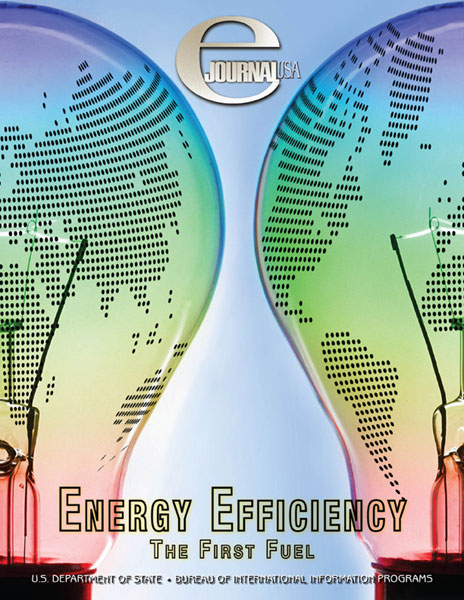- You are in:
- Home >
- Publications
Energy Efficiency: The First Fuel

April 2009
Increasing the efficient use of existing energy supplies is widely acknowledged as the fastest, cheapest, and cleanest way to meet future energy needs. Energy Efficiency: The First Fuel examines the strong U.S. record of tapping efficiency as a resource, and the accelerated efforts by individuals, organizations, and governments to squeeze greater productivity from all energy sources.
Inside This Publication
Volume 14, Number 4 | April 2009 (copy)
A Truly Global Issue
-
Energy Efficiency: Easier Said Than Done
An Interview with Matthew H. Brown and David Fridley
Two experts with broad U.S. and international experience discuss the many strategies that various national and local governments have attempted to encourage energy efficiency. -
An Oil Giant Dreams Green
Bryan Walsh, Time Magazine
Abu Dhabi, one of the world’s largest petroleum producers, has launched the Masdar Initiative, a multibillion-dollar project to establish the emirate as a center for efficiency and energy innovation. -
Virginia Learns Energy Innovations from Abroad
Dale Medearis, Senior Environmental Planner, Northern Virginia Regional Commission (NVRC)
Local officials from Northern Virginia trade ideas on climate adaptation, energy efficiency, and renewables with counterparts in Europe. -
Promoting Citizenship Through Energy Efficiency
Fábio Palmigiani, Freelance Journalist
Brazilian power companies work to educate customers about becoming legitimate bill-paying customers, leading to safer neighborhoods and a path to citizenship.
Educating Consumers
-
The Ever-Expanding Universe of Energy Star
Kathleen Hogan, Director of the Climate Protection Partnerships Division, U.S. Environmental Protection Agency
Energy Star, a U.S. government flagship program advocating efficiency, has significant influence on energy consumption in homes, businesses, and industry. -
U.S. Energy Efficiency Advances in 2009
A summary of efficiency initiatives in the American Recovery and Reinvestment Act of 2009.
-
Stimulating Efficiency for the Long Term
Stacy Angel, U.S. Environmental Protection Agency, and Larry Mansueti, U.S. Department of Energy
The U.S. energy industry and the officials who regulate it have joined forces to develop and implement new ways to bring greater efficiency to the nation’s entire energy infrastructure. -
Blogging for Efficiency
Citizens describe how they are changing their homes and habits.
-
An Energy Revolution by the People
Elisa Wood, Contributor,
www.RealEnergyWriters.com
Real gains in energy efficiency must be made by consumers one at a time, and many are encouraging creative efficiency measures in their communities. -
Vampires in the House
Many common household appliances consume energy even when they are not in use.
-
Oil Companies Embrace Energy Efficiency
Patrick Crow, Freelance Journalist
Big oil companies are running major ad campaigns to get consumers to use energy more wisely, demonstrating just how serious the energy efficiency movement has become. -
Big Oil Goes Green
Large U.S. oil companies’ campaigns on energy efficiency are summarized.
-
Effici-Facts
-
1
-
Energy conservation is any behavior that results in the use of less energy. Energy efficiency is the use of technology that requires less energy to perform the same function.
Source: The National Energy Education Development Project, whose mission is to promote an energy-conscious society. The NEED Project creates networks of students, educators, business, government, and community leaders to design and deliver energy education programs.
-
- 2
- 3
- 4
- 5
- 6
- 7
-
8
-
Using recycled material almost always consumes less energy than using new materials. Recycling a pound of steel saves enough energy to light a 60-watt light bulb for 26 hours. Recycling a ton of glass saves the equivalent of nine gallons of fuel oil.
Source: The National Energy Education Development Project
-
-
1
Video
- Home
- American Life
- Economy
- Global Challenges
- International Relations
- World Regions
- Multimedia
- Publications
This site delivers information about current U.S. foreign policy and about American life and culture. It is produced by the U.S. Department of State's Bureau of International Information Programs. Links to other Internet sites should not be construed as an endorsement of the views contained therein.
- Services:
- Email Updates
- RSS Feeds
- Mobile
- Weekly Newsletter
- Multimedia:
- Webchats & Webcasts
- Blogs
- Photo Gallery
- Podcasts
- Video
- Publications:
- eJournal USA
- Books
- Student Corner



